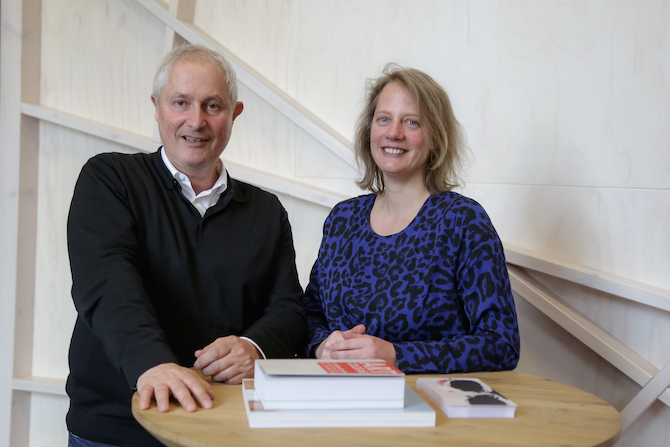
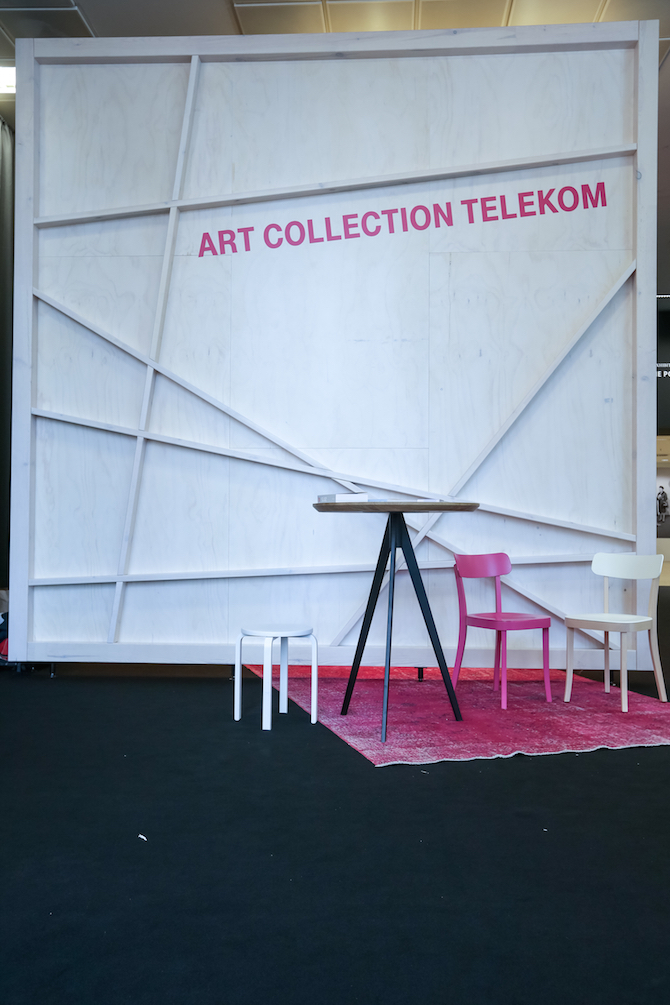
Rainald Schumacher and Nathalie Hoyos at booth Art Collection Telekom; © Deutsche Telekom AG; photos by Norbert Ittermann
– In Collaboration with Deutsche Telekom AG –
Two giant and viciously looking pigs float above a cityscape, opening their mouths and chewing on the architectural fundament of civil life. A hand cuts off a pig’s tail; the blood spreads into the sky. Painted inside the booth of Art Collection Telekom, the 1976-born Ukrainian artist Volodymyr Kuznetsov created the work during the installation phase for Art Cologne 2015. It refers to Koliyivshchyna, a bloody Ukrainian rebellion against Poland in 1768; and it asks what could be the next step after such immense brutality.
Assembled by the curators Nathalie Hoyos and Rainald Schumacher, and directed by Antje Hundhausen, the five-year-old Art Collection Telekom emphasises the contemporary art scene in Eastern Europe. Originally initiated on the occasion of the Telekom’s recently established national companies for communication services in countries such as Romania and Poland, their bonds to Eastern Europe now imply a visual dialogue and exchange.
The collection neither focusses on decorative works for corporate headquarters, nor on big names. It consists of art works that intend to create a cultural understanding, such as the works by 1986-born Kosovan artist Petrit Halilaj, who currently has a solo show at Kölnischer Kunstverein. One of the collection's major concerns is the support of young Eastern European artists, and especially those, whose works are controversially raising the awareness of social change. Nathalie and Rainald, who are both experienced in managing large collections, have been a part of the small team from the beginning on. I spoke with them about their curatorial work for the collection.
Anna-Lena Werner: Nathalie and Rainald, over the past five years you have built and established the art collection Telekom with a focus on Eastern and South-Eastern European contemporary art. How did you, personally, develop a focus on Eastern European art?
Nathalie Hoyos: I always had an interest in the region and in the changes happening there. In 2010 it seemed like a good moment to explore an area where history was being re-written. We were not that early, but early enough to observe the changes happening in the region.
Rainald Schumacher: I had previously worked for the Sammlung Götz, which includes several Eastern European artists, but only those who are greatly accepted in the western art world. The hyped ones. There was a lack of information about local scenes. And this information was difficult to access, also for me.
Anna-Lena: Why was the regional emphasis developed for the collection?
Rainald: Our proposal that we had developed for Telekom was based on the idea of exploring a new territory, instead of collecting names from the existing market. Eastern Europe is an exciting region for collecting art, because the knowledge about its scene is still a blank page. Many Eastern European societies are still part of dramatic changes, striving for freedom and democracy. These subjects become part of our discussions, too.
Anna-Lena: Do you get to know artists in these regions through galleries or directly?
Nathalie: Both. We get to know artists and galleries, each recommending other artists and introducing us to new work. We try to be on site, in order to get to know the scene directly.
Rainald: The scene is very open. All artists show solidarity: They know each other, they work together, and they create groups. We do try to work with local galleries, but there is one problem: Apart from Poland, hardly any of these countries have a functioning gallery network. Rumania, for example, has five galleries and four collectors. Ukraine does not even have one gallery doing continuous work. If artists come to the surface, international galleries pick them up and make their work unavailable for their own country. Thus, many of these countries dry out culturally.
Nathalie: Yes, although many of the artists do actually return to their countries and support institutes and artist communities.
Anna-Lena: Do you only collect young positions, or also older artists who witnessed the dissolution of the Soviet Union?
Nathalie: We do have a few artists from an older generation, to which the younger artists refer. There are also several mid-aged artists. Generally, we try to balance the generations in the collection.
Rainald: Some of the younger artists tell us about influential, local positions from the 60s and 70s. We do make an exemplary selection of these artists, securing a few small highlights. However, many of these works are not available, because they are already sold out. Institutes such as Tate Modern or Centre Pompidou began to specialise in Eastern European art and began acquiring works a couple of years ago.
Anna-Lena: Are there specific characteristics in Eastern European art as opposed to typically western art?
Nathalie: The art is sometimes produced under very different, sometimes dramatic circumstances. Their works often tell a story about what they have experienced, they are more narrative.
Rainald: Ukraine has many artistic groups, developing civil methods and initiatives to change the encrusted Soviet social structures. The content of their works is very different. Sometimes it is a bit more controversial and more emotive. The economical shortage sometimes forces artists to focus on what it important. Since the market is so small in this area, there is a concentration, instead of a serial mass production of sellable works. A classic artist studio in the Ukraine is a small niche in a small kitchen. It is not a 200 square metre loft with two assistants. That is why the Telekom’s commitment is so important, because it helps the artist to pursue their work.
Anna-Lena: How did you experience the art academies in Eastern Europe?
Rainald: They are somehow trapped in post-soviet structures. It is very academic, focused on the representational handcraft of drawing and painting. Students who are most technically skilled are then often appointed to the highest league of artistic practice: monumental sculpture. This, of course, is part of the Soviet tradition. There is a lack of art theory.
Anna-Lena: Which country in Eastern Europe is most underestimated in terms of its art scene?
Rainald: Many of the new states of the former Socialist Federal Republic of Yugoslavia. The communist systems were more open. They actively supported abstract art, they allowed artists to travel and TV from Western Europe was available. There is a lively Avant-garde of the 60s and 70s. Also Rumania has something similar. Some countries were dominated by Soviet cultural politics and cut off from events in the West, so that cultural movements are often delayed. Sometimes by 20 or 30 years.
Nathalie: That is why we need to use different criteria when we look at these works. For some cultural circles something may be visionary, while others might consider it a repetition of the past.
Anna-Lena: Which countries in Eastern Europe haven’t you explore yet?
Rainald: Countries with dictatorships, such as Belarus. Artists from Ukraine have told us that Belarus has a real underground culture with clubs, bars, illegal galleries and performances. We need to research a bit more.
Anna-Lena: A selection of Art Collection Telekom was exhibited at me Collectors Room in Berlin in 2014 under the exhibition title ”Fragile Sense of Hope”. Are you planning further public shows with the works of the collection?
Nathalie: The collection will be shown at the Museum for Contemporary Art in Bucharest, in Spring 2016. The museum will co-curate the show, integrating their view on the collection.
Rainald: We can probably learn from their reflections. We would also like to show the collection in other parts of Eastern Europe, in order to increase the perception of contemporary positions. This is very important to us. We want to prevent a neo-colonialism of western collections acquiring Eastern European works and withdrawing them entirely from their countries.
Art Collection Telekom can be explored online: art-collection-telekom.com
Video-Interview with Volodymyr Kuznetsov: Online
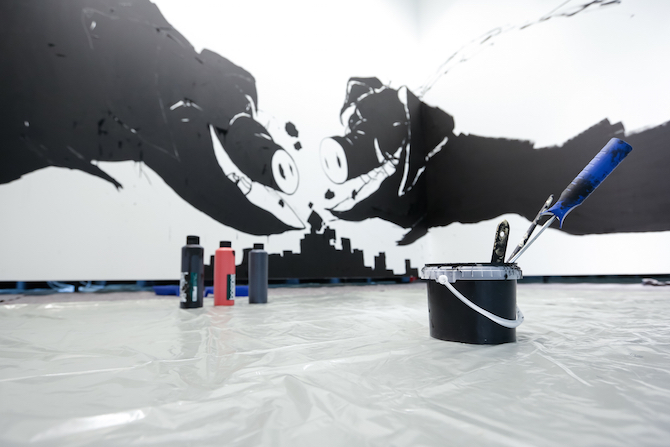

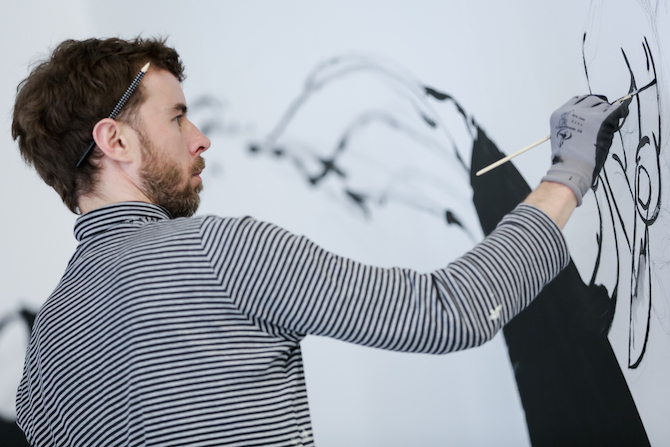

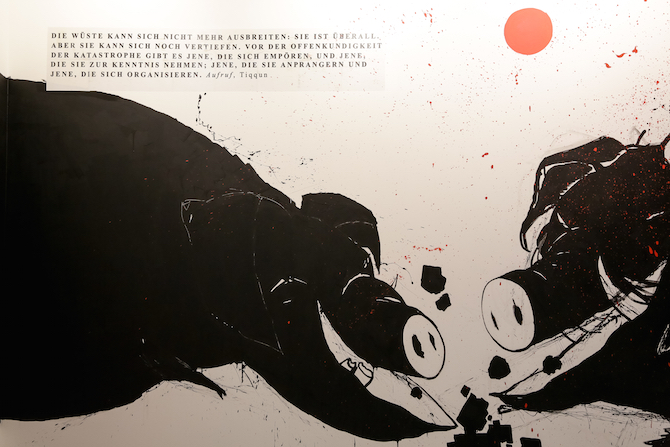
painting by Volodymyr Kuznetsov at booth Art Collection Telekom; Art Cologne 2015 © Deutsche Telekom AG; photos by Norbert Ittermann
– In Collaboration with Deutsche Telekom AG –
